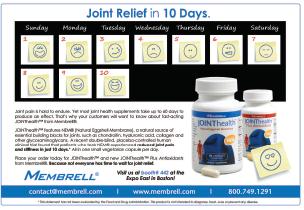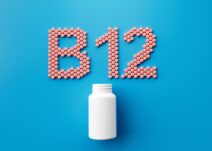Mom was right when she said, “Don’t forget to take your vitamins.” But, perhaps, she should have added minerals, too, as they affect many critical aspects of the body’s inner workings.
The Balancing Act
Most consumers know that calcium is important for building strong bones. But, what they may not understand is its link to magnesium for proper bone health.
To get a better sense of how this works, let’s start with the parathyroid hormone (PTH). Magnesium is needed for the secretion of this hormone, which stimulates osteoclasts to reabsorb bone mineral and release calcium in the bloodstream. Also, PTH helps the small intestine absorb calcium by stimulating the production of vitamin D. And, it suppresses calcium excretion in urine. Magnesium may also change the movement of calcium across cell membranes by inhibiting its release from the sarcoplasmic reticulum (1).
Calcium and magnesium also are interrelated in other body functions. Together, the two regulate heartbeat by contracting and relaxing as necessary. And, calcium stimulates nerves, whereas magnesium calms them down. When it comes to the blood coagulation process, calcium is also necessary for clotting, while magnesium helps keep the blood flowing freely. Last, calcium is mostly found in bones and gives them much of their hardness, and magnesium is found mainly in soft structures (2).

Given their complex relationship, most experts agree that the proper calcium–magnesium ratio is 2:1. So, if customers take 1,500 mg of calcium daily, they should try to consume 750 mg of magnesium too, which may help prevent an imbalance. But, some feel magnesium and calcium supplements should be taken at different times in order to allow each mineral to absorb (1).
The relationship between sodium and potassium also is a delicate one. Potassium and sodium coexist at the cellular level, and regulate the transfer of nutrients into the cell and waste out of the cell through the cell’s membrane. For this balancing act to take place, it is recommended that between two to five times as much potassium as sodium is taken. Unfortunately, too many people have an opposite proportion, which can lead to heart health issues.
How does the sodium-potassium pump work? Positive sodium ions on the outside of the cell are drawn to negative potassium ions located in high concentration inside cells. The charge between the two minerals can be likened to a magnetic force; potassium and sodium attract one another, thereby creating an electrochemical gradient known as membrane potential. Membrane potential is important for proper heart function, for nerve impulse transmission and for muscle contraction.
If there is too much sodium and too little potassium in one’s system, the pump has to work that much harder to keep too many sodium ions from invading the cell (3). This can cause a chain of reactions that leads to high blood pressure and unnecessary strain on blood vessels, the heart and the kidneys. Studies have shown a link between chronic levels of low potassium and kidney disease, lung disorders, hypertension and even stroke (3). Conversly, when potassium and sodium are in balance, cells, nerves and muscles function as they should.
Low potassium levels have been associated with lung disorders, kidney disease and hypertension (in both adults and children). A recent trial gauged the severity of chronic dietary potassium depletion on blood pressure and structural changes of the kidney in young rats. Rats were fed either a control or a
potassium-deficient diet for 14 to 21 days. At the end of the testing period, blood pressure and renal activity was gauged. Next, the remaining rats in each group were either switched to a high-salt diet or continued on their control or potassium-deficient diets for six more days (3, 4).
The animals that had decreased intake of potassium experienced significant growth retardation, kidney damage and injury to the lungs. And, during the second week, potassium-depleted rats had a higher systolic blood pressure than the control rats. Researchers concluded that the potassium deficiency increased blood pressure in young rats and induced salt sensitivity that may be involved in at least two different pathogenic pathways (4).
Before leaving the topic of the sodium–potassium pump, it should be noted that magnesium is needed for the pump to function properly. When a magnesium deficiency occurs, pumping sodium out of the cell and pumping potassium into the cell can become impaired.
Another interesting pairing is copper and iron, which are needed for the normal production of hemoglobin. Nearly all of the body’s iron is found in hemoglobin, which is present in the red blood cells and myoglobin (found in muscle cells). However, in both, iron helps accept, transport and then release oxygen. To that very end, iron is said to be useful for those who have anemia, a blood condition in which the amount of hemoglobin in red blood cells or the number of red blood cells in the body is abnormal.
Copper’s role involves assisting the body with absorbing and using iron to synthesize hemoglobin (5). How does this happen? Put simply, it works by latching onto the enzyme superoxide dismutase (SOD). SOD is a free radical scavenger that prevents cellular damage associated with the aging process and asthma. And, copper also sticks to proteins to form ceruloplasmin, which is a serum glycoprotein involved in the storage and transportation of copper and iron. Together, they do their jobs by making sure the right amounts of hemoglobin are present in the body.
A research team evaluated the interaction of copper and iron metabolism in anemic rats by giving them diets with the same iron concentration and varying copper levels (6). Overall, increased levels of hemoglobin, hematocrit and serum iron were observed with increased copper concentration. Low hematological levels were more than likely the result of a deficiency in ceruloplasmin and cytochrome c oxidase (copper-dependent enzymes required for iron metabolism).
Not to be Taken Lytely
You may associate electrolytes with energy drinks, but there is much more to them.
Electrolytes are used by the cells to maintain electric voltages across their membranes and to carry electrical impulses between the cells. Potassium, calcium, sodium, magnesium and chloride each function as electrolytes in fluids in the body (7). Though it is natural to lose electrolytes through perspiration, their loss can cause muscle cramping and other ill effects when they are depleted quickly during exercise or periods of dehydration (such as from diarrhea). Several supplement companies have launched tasteless electrolyte beverage add-ins so that these minerals can be replenished without the use of sugary sports drinks.
Take a Minute for Minerals
Here is a smattering of some other important minerals for proper health:
• Chromium is said to be beneficial for those with diabetes. In one trial, overweight individuals with a family history of diabetes were given 1,000 mg of chromium on a daily basis. Four months later, their insulin resistance deflated considerably, and significant improvement continued until the end of the eight-month trial. According to the researchers, “This is a potentially important finding in light of the fact that insulin resistance often precedes type 2 diabetes. Chromium picolinate is a nutritional supplement that can reduce risk factors for the development of diabetes,” (2, 4).
• A study published in the Journal of Complementary Medicine found vanadium may make the body use insulin more efficiently, thereby reducing the need for taking extra insulin (2).
• Silicon may be beneficial for skin and joint health (such as for arthritis sufferers). The body needs this trace mineral to build healthy connective tissue and for collagen formation (2).
• Selenium and zinc are beneficial for those who have weakened immune systems, which may have been caused from the common cold or flu. Thus, deficiencies in selenium and zinc can be particularly dangerous for the elderly, who may already have compromised immune systems. A two-year study on 725 geriatric patients indicated that those who took low doses of zinc and selenium developed an increase in infection-fighting antibodies and had fewer incidences of respiratory tract infection (2). Also, research supports the use of selenium against prostate and other cancers.
• Boron, which is said to prevent bone loss, may decrease osteoarthritis and improve bone density.
• Manganese is said to bolster bone growth.
• Iodine is helpful for maintaining a healthy thyroid gland, counteracting hypothyroidism and for the prevention of goiters.
• Phosphorus is a necessary mineral for maintaining healthy bones and joints; it also is needed for the utilization of carbohydrates, protein and fats. WF
References
1. R. Jalali, “Magnesium: The Multi-Purpose Mineral,” www.thinkmuscle.com/articles/jalali/
magnesium.htm, accessed October 19, 2009.
2. J. Challem and L. Brown, Basic Health Publications User’s Guide to Vitamins & Minerals (Basic Health Publications, Laguna Beach, CA, 2002).
3. B. Stone, “The Importance of the Potassium and Sodium Balance,” www.brighthub.com/health/
alternative-medicine/articles/43423.aspx, accessed October 19, 2009.
4. B. Minton, “Balance Sodium with Potassium for Good Health,” www.naturalnews.com/
024539_potassium_sodium_blood.html, accessed October 20, 2009.
6. L. Ramírez-Cárdenas, N.M. Brunoro Costa, F. Pinheiro Reis, “Copper–Iron Metabolism Interaction in Rats,” Nutrition Res. 25 (1), 79–92 (2005).
7. M. Essig, “Electrolytes and Electrolyte Imbalances,” Health Magazine, www.health.com/health/
library/mdp/0,,ste122049,00.html, accessed October 13, 2009.
Published in WholeFoods Magazine, Dec. 2009

2025 Natural Choice Awards
March 31, 2025








